
Georgia
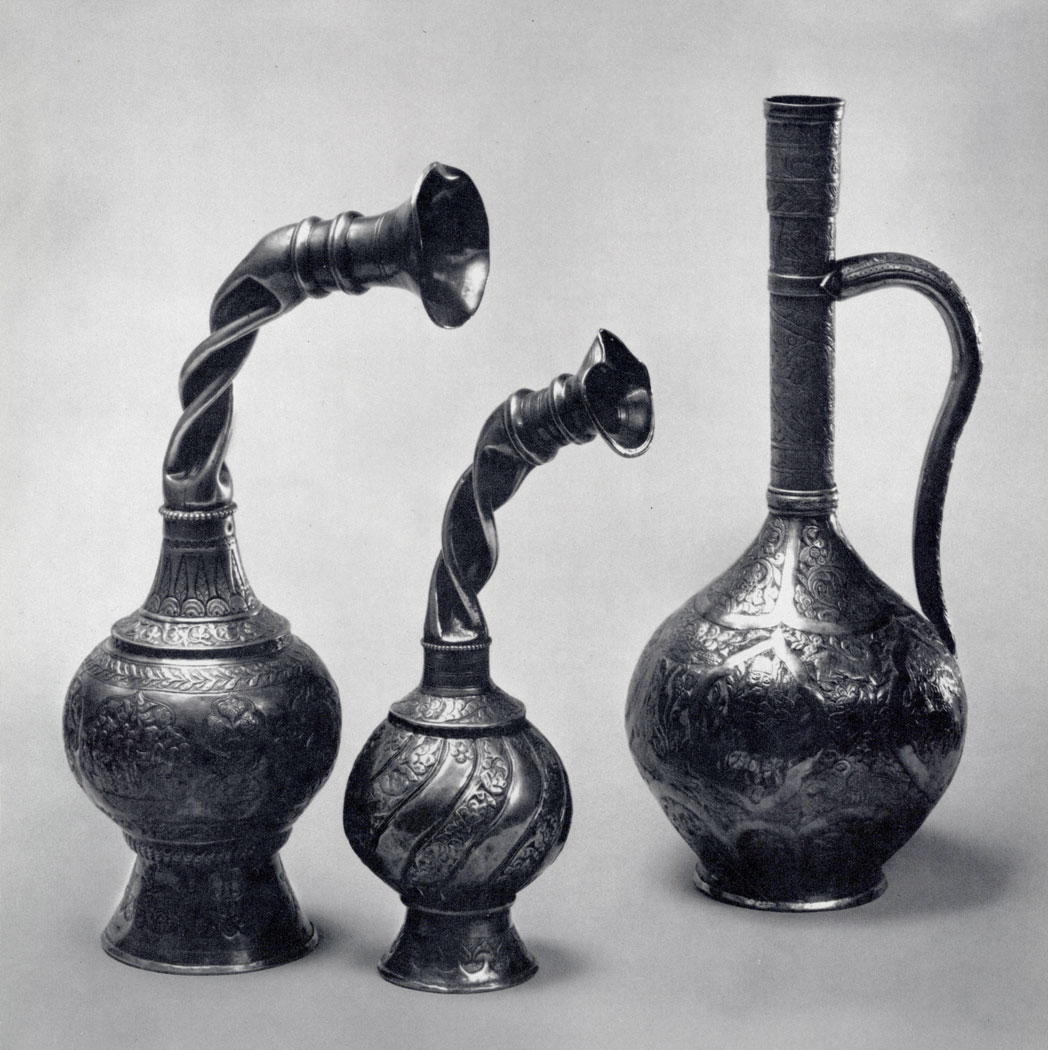
Wine vessels
Georgia. Second half of the 19th century
Chased silver.
Height 38 cm, diameter 12.5 cm
Inv. No. 2172 III
Received in 1924 from the State Museum Reserve, Moscow.
Chased silver.
Height 28 cm, diameter 10 cm. lnv. No. 3743 III
Received in 1952 from the Art Museum of Georgia, Tbilisi.
Chased silver.
Height 38 cm, diameter 15.5 cm. Inv. No. 2167 III
Received in 1924 from the State Museum Reserve, Moscow. First publication.
These jugs are typical of the wine vessels used in wealthy Georgian households in the 19th century. The shapes, ornamental motifs and techniques displayed by the articles are deeply rooted in old local traditions. Such jugs adorned festive tables; and because of the twisted shape of their necks the wine, as it was poured from the vessels, gave out a melodious sound.
Nabadi carpet
By Tina Bishunaridze (born 1914). Village of Kvemo-Alvani, Georgia. 1973
Felt.
148 × 56 cm. Inv. No. 24870
Acquired in 1974. First publication.
The making of felt articles is one of the most ancient kinds of textile art.
Felt carpets-nabadis-have always been common among hunters and shepherds in the mountainous areas of Georgia. Beautiful felt and woollen articles from the village of Kvemo-Alvani are well-known outside the Caucasus. The village was founded about two hundred years ago in the Alazani valley by Tushetian Highlanders. Ever since that time, the men of that village have left for the alpine pastures with their sheep for the spring and summer and have descended to the valley to spend the autumn and winter with their families.
Nabadis are produced in two or more colours. Their decor is laconic and unpretentious, their colouring bright and cheerful. Various combinations of traditional ornamental motifs (stylized plant, geometric and zoomorphic ones) and brilliant saturated colours account for the highly expressive pictorial compositions of Tushetian felts. The technique used in their making is fairly simple. Unhampered by any rigid compositional or ornamental canons, the carpet-makers are free to indulge their creative fancy. That is why, in spite of an apparent general stylistic uniformity, Tushetian nabadi carpets are extremely varied in their ornamentation.
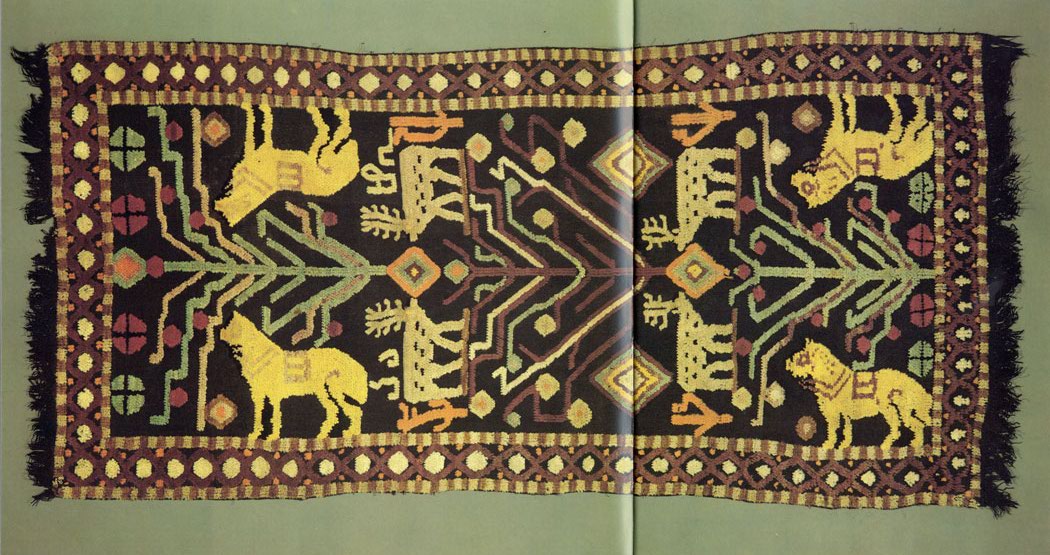
Pardagi carpet
Akhmeta District, Georgia. 1920s
Wool (mixed technique).
234 × 113 cm. Inv. No. 24879
Acquired in 1974.
This Tushetian carpet is eloquent evidence of the vitality of traditional subjects which have their origin in pagan times. The motif of the Tree of Life is one of the oldest and most widely spread motifs in world art. Many different nations have this motif in their artistic repertory. The carpet in question presents a specific local interpretation of this subject. Tushetian carpets usually have a pileless background which sets off brightly coloured geometric or stylized zoomorphic designs in piled wool. Zoomorphic motifs come as a natural reflection of the way of life of Tushetian people: hunting, cattle-breeding and vine-growing are among their major preoccupations. The creative imagination of Tushetian carpet-makers transforms real objects and living things into artistic images whose aesthetic charm lies in a harmonious unity of the ancient canonical schemes and the naive manner of expressing the main idea.
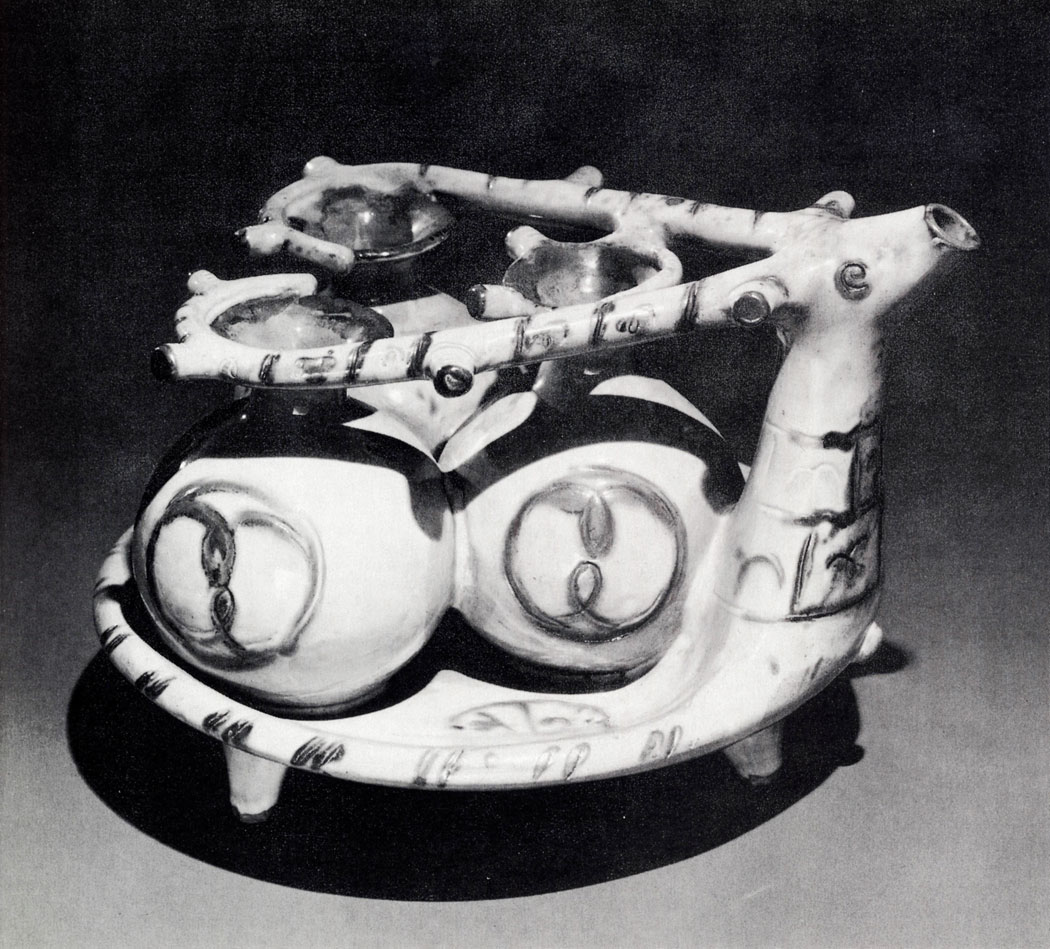
Marani wine vessel for wedding-table
By Aide Kakabadze (born 1932). Tbilisi, Georgia. 1963
Clay, painted and glazed.
32 × 36 × 51.5 cm. lnv. No. 5547 III
Acquired in 1969 from the Contemporary Georgian
Ceramics and Metalwork Exhibition, Moscow.
Ceramics is one of the oldest and most traditional crafts of Georgia.
Many earthenware articles produced nowadays can be associated with the traditions of the early Caucasian smoked and burnished pottery (3rd and 2nd millennia BC) and the medieval lustre pottery of the Near East. Contemporary Georgian potters do not only reveal the secrets of ancient masters but also bring a new creative touch to their artistic methods. Drawing from the repertory of traditional forms, the Georgian craftsmen of today produce highly original articles of lasting quality. Georgian pottery is characterized by a variety of shapes and by the combination of utility with artistic perfection.
This vessel derives its shape from traditional wedding-table wine vessels. Such vessels were in common use in Georgia for many centuries. But the ma-rani reproduced here is not a simple mechanical reconstruction of an early model. The artist endowed it with an up-to-date clarity and precision of form, emphasized by the "metallic" texture of the surface. The glazed vessel is decorated with simple ornamentation characteristic of Georgian peasant pottery of the 19th century. The inside of the marani is also covered with waterproof glaze which complements the vessel's decorative function with a pragmatic one.
Jug
By Revaz Metreveli (born 1930). Georgia. 1965
Clay, smoked, burnished and engraved; glaze applied in the process of second firing.
Height 21 cm, diameter 11 cm. Inv. No. 23999 КП
Acquired in 1973. First publication.
Contemporary Georgian ceramics testifies to an extremely high level of technical skill and the excellent workmanship of the potters. One of its most attractive features is the ever-present illusion of hand-modelling. Revaz Metreveli's jug has a sturdy rounded shape which seems to be imparted to it by the potter's hand alone, without the help of the wheel. Its thin sides are decorated with brilliantly coloured glazes whose intricate play on the black background of the jug is as dazzling as that of precious enamels and gems.
In its austerity of forms and precision of proportions the vessel resembles its ancient antecedents. Both the deep black colour which is achieved by means of special baking technique and the ornamental motifs are also traditional. At the same time the potter did not merely repeat the old patterns but interpreted them in his own creative way giving a new life to time-honoured traditions.
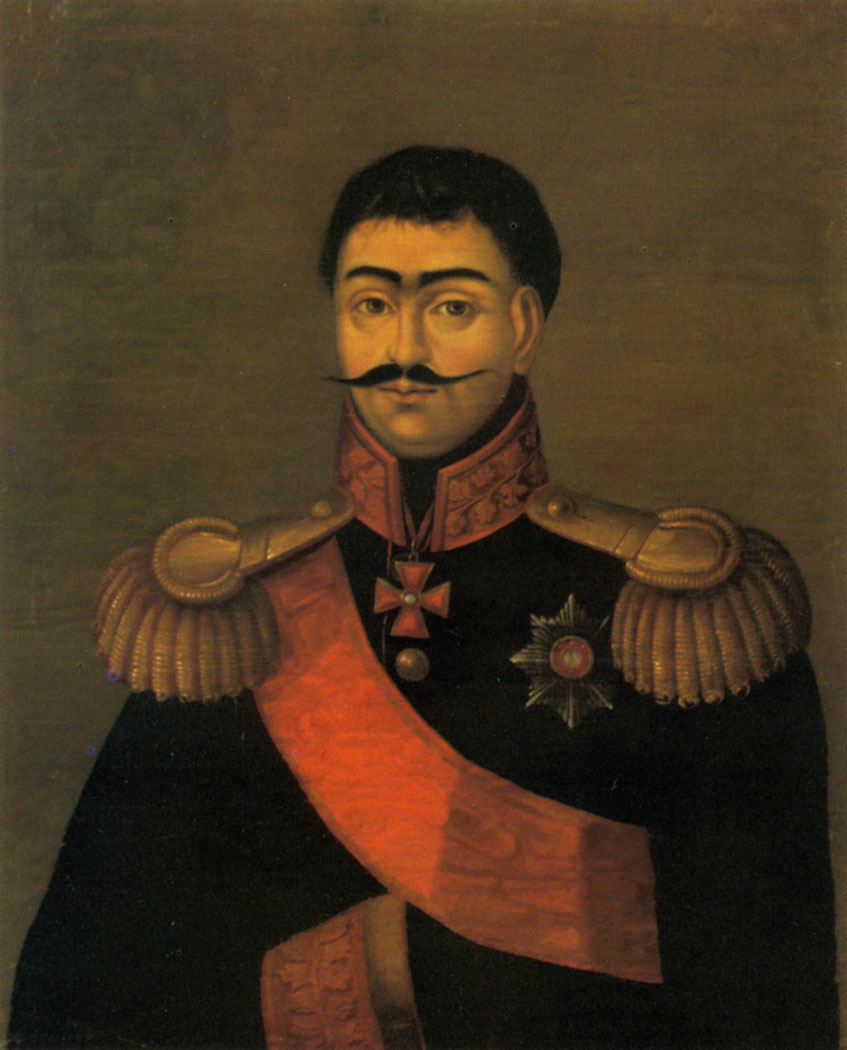
Portrait of Prince
Tamas Jambakur Orbeliani. By anonymous artist. Georgia. First half of the 19th century
Oil on canvas.
67.5 × 81 cm. Inv. No. 2512 III
Acquired in 1938 from the State Purchasing Commission, Moscow.
During the first half of the 19th century numerous portrait painters Were active in Tifiis (now Tbilisi). The names of many of them have not reached us. Their works mark the period of transition from the flatness and conventionality of late medieval painting to a new, realistic pictorial manner. This portrait by an unknown artist is a characteristic example of the creative pursuits of the time.
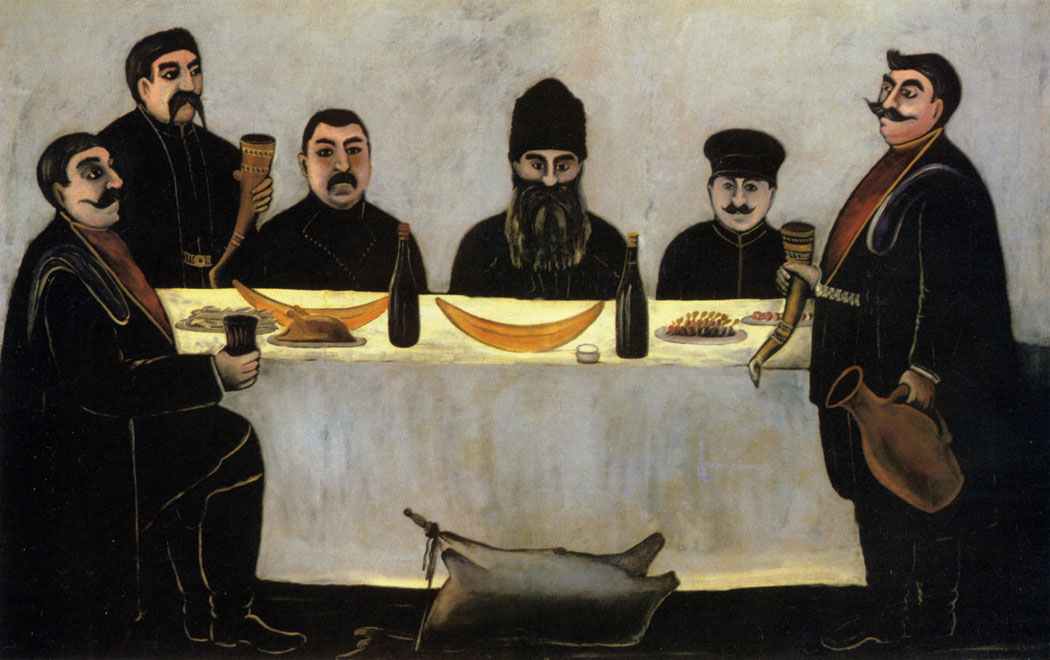
Carousal
By Niko Pirosmanashvili (1862-1918). Georgia. 1905-7
Oil on oil-cloth.
177 × 113 cm. Inv. No. 2897 III
Received in 1945 from the Metekhi Museum (now the Art Museum of Georgia), Tbilisi.
Pirosmanashvili was born in the village of Mirzaani, Georgia, and lived and worked in Tiflis (now Tbilisi). He had no professional education. A born artist, Pirosmanashvili depicted life as he saw it, without resorting to accepted, conventional pictorial techniques. He derived his imagery from his visual impressions and intuition, but he never painted directly from life-his memory and his imagination were the only sources for his pictures. His creative work was inseparably linked with national artistic traditions.
Pirosmanashvili's legacy includes numerous canvases depicting the life of old Tiflis and Georgian customs. One of his favourite subjects was the Georgian feast-a festive meal whose origin goes back to ancient rituals.
The compositions of these scenes in Pirosmanashvili's pictures, even though they may vary in details from painting to painting, go back to one and the same model-medieval Georgian wall-paintings of the Last Supper.
The picture reproduced here is remarkable for the expressiveness of the images and its skilful brushwork.
Native of Ajaria
By Yelena Akhvlediani (1901-1975). Georgia. 1927
Oil on cardboard.
70 × 53 cm. Inv. No. 2504 III
Received in 1936 from the State Purchasing Commission, Moscow.
A People's Artist of Georgia, Yelena Akhvlediani was born in Telavi. She studied at the Sklifasovsky and Shebuyev Art Studio inTiflis(now Tbilisi) in 1922 and in 1922-27, as a scholarship-holder of the Tiflis, Academy of Arts, at the Colorossi Academy in Paris and at private art studios in Milan, Rome and Venice. In 1920-21, she taught drawing at a secondary school in Tiflis and thereafter she continued to live and work there. Yelena Akhvlediani was active in various genres: easel painting, graphic work and stage-set design, but she is best known as a master of city views.
The painting reproduced here belongs to the early period of the artist's career, which was characterized by romantic inclinations.
Portrait of Nino Gudiashvili
By (Lado) Vladimir Gudiashvili (1896-1980). Georgia. 1930
Watercolours and pencil on paper. 58.5 × 43 cm. Inv. No. 4673 III
Received in 1961 from the Board of Art Exhibitions and Panoramas attached to the USSR Ministry of Culture, Moscow.
A People's Artist of Georgia and Shota Rustaveli Prize Winner, Gudiashvili was born in Tiflis (now Tbilisi). He studied at the Art Studio in Tiflis (1910-18) and at the Ronsard Academy in Paris (1919-26). Gudiashvili taught at the Tiflis Academy of Arts (1926-34).
Lado Gudiashvili belongs to the first generation of contemporary Georgian artists. His creative interests included easel painting, graphic work and stage-set design. His favourite subjects came from the life of Tiflis bohemia. His pictures gave new life to the images and characters of old Georgian poetry and prose. Gudiashvili was a fine connoisseur and admirer of medieval Western European and Oriental art, especially the art of painting miniatures with their refined linear decorativeness-their influence on his idiom can be clearly seen in his works.
Wrestling
By Tengiz Mirzashvili (born 1934). Georgia. 1960
Tempera on cardboard.
50 × 60 cm. lnv. No. 6641 III
Received in 1972 from the Board of Art Exhibitions and Panoramas attached to the USSR Ministry of Culture, Moscow.
One of the leading Georgian artists, Mirzashvili began his career in the 1960s. He was born in Mestia, Georgia, into an artist's family. He studied at the Tbilisi Academy of Arts. From 1959 to 1961 he took a postgraduate course at the Academy. Since 1962
Mirzashvili has taught drawing at the Tbilisi Academy of Arts. Since 1957 he has been an active contributor to art exhibitions. He is active as a painter, graphic artist and theatre designer. Mirzashvili is a born easel painter and a master of composition. His favourite medium is tempera, and his paintings are usually small and executed with great care and deliberation. His artistic world is harmonious, capacious and poetic. Most of his paintings depict peasant life with its constant "rapport" with nature, unyielding fortitude, natural simplicity and a somewhat patriarchal flavour. In Mirzashvili's pictures the daily routine of peasant labour acquires dignity, loftiness and an aesthetic value of its own. The picture reproduced here is one of the artist's fairly typical works. It reveals all the most characteristic traits of his manner: the sculptural plasticity of human bodies, a seemingly static, but inwardly intense composition, the touch of eternity imparted to trivial momentary events and, finally, the noble colour range culminating in greenish, ochre and brown-reddish tints. Mirzashvili derives the emotional tension of his paintings and, in fact, his artistic culture as such, from the traditions of national art which he follows both consciously and intuitively.
|
ПОИСК:
|
© MUSEUMS.ARTYX.RU, 2001-2021
При использовании материалов сайта активная ссылка обязательна:
http://museums.artyx.ru/ 'Музеи мира'
При использовании материалов сайта активная ссылка обязательна:
http://museums.artyx.ru/ 'Музеи мира'